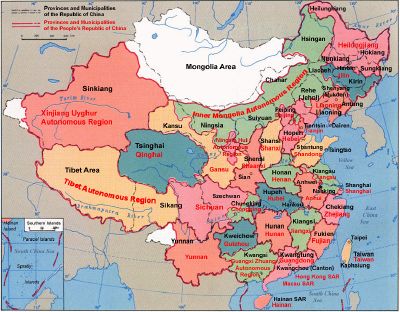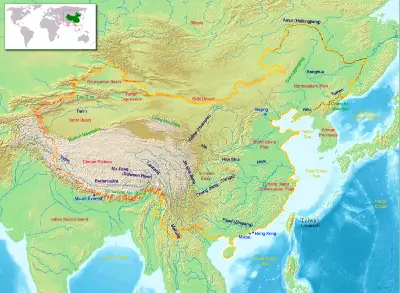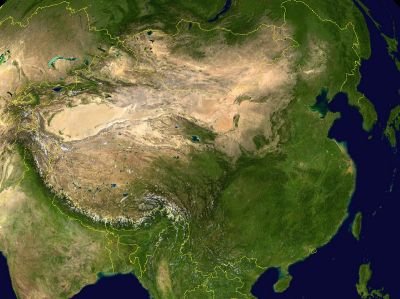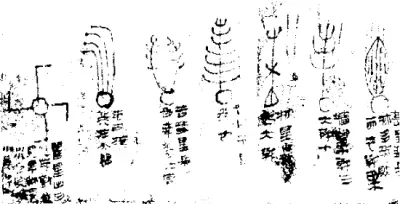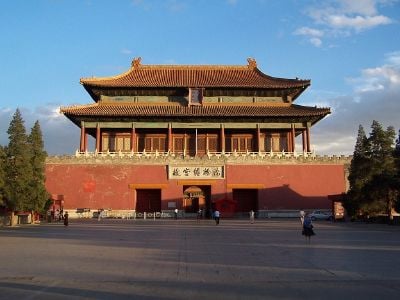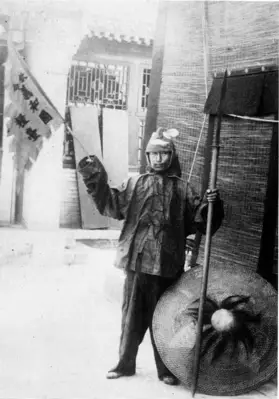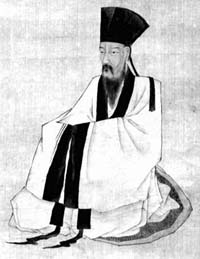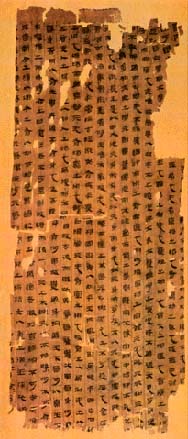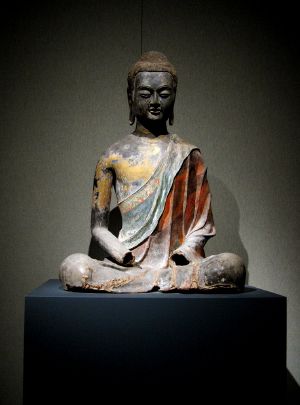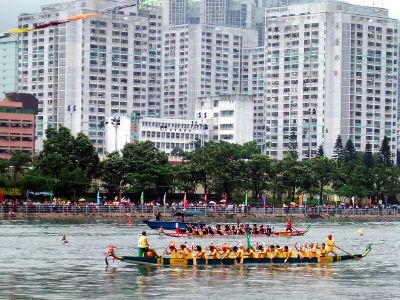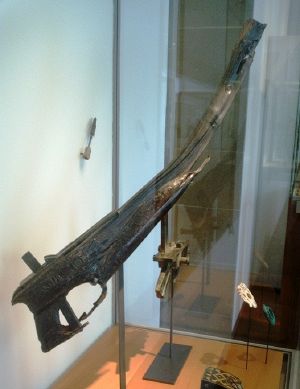China
This article focuses on the civilization of China and its history. For contemporary countries, see the People's Republic of China (mainland China) and the Republic of China (Taiwan).
China (Traditional Chinese: 中國; Simplified Chinese: 中国; Hanyu Pinyin: Zhōngguó; Tongyong Pinyin: Jhongguó) is a cultural region, ancient civilization, and nation in East Asia. It is one of the world's oldest civilizations, consisting of states and cultures dating back more than six millennia. As one of the world's oldest continuous civilizations, it has the world's longest continuously used written language system: Chinese characters. It is also said to be the source of some of the world's great inventions, including the Four Great Inventions of ancient China: paper, the compass, gunpowder, and printing.
China has been a major source of inspiration and life in terms of religion, philosophy, culture, and language. However, it has also been the place of conflicting ideologies. This has led to difficulties in terms of modernization and full appreciation of Chinese culture in the modern world.
The stalemate of the Chinese Civil War that ended in 1949 resulted in two political entities using the name China: the People's Republic of China (PRC), administering mainland China, Hong Kong, and Macau; and the Republic of China (ROC), also known as Taiwan, administering Taiwan and its surrounding islands.
Etymology
China is most commonly called Zhongguo in Mandarin Chinese. The first character zhōng (中) means "middle" or "central," while guó (国 or 國) means "country" or "state." Missionaries first translated the term as "Middle Kingdom." In ancient times the name referred to the "Central States" along the Yellow River valley and was not associated with any single political entity. The nomenclature gradually evolved to mean the lands under direct imperial rule.
English and many other languages use various forms of the name "China" and the prefix "Sino-" or "Sin-." "China" appears in Richard Eden's 1555 translation of the 1516 journal of the Portuguese explorer Duarte Barbosa.[1] Barbosa's usage was derived from Persian Chīn (چین), which was in turn derived from Sanskrit Cīna (चीन). Cīna was first used in early Hindu scripture, including the Mahābhārata (fifth century B.C.E.) and the Laws of Manu (second century B.C.E.).
In 1655, Martino Martini suggested that the word China is derived ultimately from the name of the Qin dynasty (221–206 B.C.E.). "Qin" is pronounced as "Chin" which is considered the possible root of the word "China."[2] The Qin Dynasty unified the written language in China and gave the supreme ruler of China the title of "Emperor" instead of "King." Therefore, the subsequent Silk Road traders might have identified themselves by that name. Although this derivation is still given in various sources, it is complicated by the fact that the Sanskrit word appears in pre-Qin literature.
Geography
China ranges from mostly plateaus and mountains in the west to lower lands in the east. Principal rivers flow from west to east, including the Yangtze (central), the Huang He (Yellow River) (north-central), and the Heilongjiang (Amur) (northeast), and sometimes toward the south, including the Pearl River, Lankong (Mekong), and Yarlung Tsangpo (Brahmaputra), with most Chinese rivers emptying into the Pacific Ocean.
Most Chinese dynasties were based in the historical heartlands of China, known as China proper. Various dynasties also expanded into peripheral territories like Inner Mongolia, Dong-Bei (Northeast), Xinjiang, and Tibet. The Manchu-established Qing Dynasty and its successors incorporated these territories into China. China proper is generally thought to be bounded by the Great Wall and the edge of the Tibetan Plateau. Dong-Bei and Inner Mongolia are found to the north of the Great Wall, and the boundary between them can either be taken as the present border between Inner Mongolia and the northeast Chinese provinces, or the more historic border of the World War II-era puppet state of Manchukuo. Xinjiang's borders correspond to today's administrative Xinjiang. Historic Tibet occupies all of the Tibetan Plateau.
In the east, along the shores of the Yellow Sea and the East China Sea there are extensive and densely populated alluvial plains. On the edges of the Inner Mongolian plateau in the north, grasslands can be seen. Southern China is dominated by hills and low mountain ranges. In the central-east are the deltas of China's two major rivers, the Huang He and Yangtze River. Most of China's arable lands lie along these rivers; they were the centers of China's major ancient civilizations. Other major rivers include the Pearl River, Lankong, Yarlung Tsangpo, and Heilongjiang. Yunnan Province is considered a part of the Greater Mekong Subregion, which also includes Myanmar, Laos, Thailand, Cambodia, and Vietnam.
In the west, the north has a great alluvial plain, and the south has a vast calcareous tableland traversed by hill ranges of moderate elevation, and the Himalayas, containing Earth's highest point, Mount Everest. The northwest also has high plateaus with more arid desert landscapes such as the Takla-Makan and the Gobi Desert, which has been expanding. During many dynasties, the southwestern border of China has been the high mountains and deep valleys of Yunnan, which separate modern China from Myanmar, Laos, and Vietnam.
The Paleozoic formations of China, excepting only the upper part of the Carboniferous system, are marine, while the Mesozoic and Tertiary deposits are estuarine and freshwater or else of terrestrial origin. Groups of volcanic cones occur in the Great Plain of north China. In the Liaodong and Shandong Peninsulas, there are basaltic plateaus.
The climate of China varies greatly. The northern zone (containing Beijing) has summer daytime temperatures of more than 30 degrees Celsius and winters of Arctic severity. The central zone (containing Shanghai) has a temperate continental climate with hot summers and cold winters. The southern zone (containing Guangzhou) has a subtropical climate with very hot summers and mild winters.
Due to a prolonged drought and poor agricultural practices, dust storms have become usual in the spring in China.[3] Dust has blown to southern China, Taiwan, and Korea, and has even reached the West Coast of the United States. Water, erosion, and pollution control have become important issues in China's relations with other countries.

China is a megadiverse country, lying in two of the world's major ecozones: the Palearctic and the Indomalaya. China is home to over 500 species of mammals, over 1,000 species of birds, over 400 species of reptiles, and over 300 species of amphibians.
Hundreds of animal species are threatened, vulnerable, or in danger of local extinction in China, due mainly to human activity such as habitat destruction, pollution, and poaching for food, fur, and ingredients for traditional Chinese medicine.
China has over 32,000 species of vascular plants, and is home to a variety of forest types. Cold coniferous forests predominate in the north of the country, supporting animal species such as moose and Asian black bear, along with over 120 bird species. The understorey of moist conifer forests may contain thickets of bamboo. In higher montane stands of juniper and yew, the bamboo is replaced by rhododendrons. Subtropical forests, which are predominate in central and southern China, support as many as 146,000 species of flora.[4] Tropical and seasonal rainforests, though confined to Yunnan and Hainan Island, contain a quarter of all the animal and plant species found in China.[4] China has over 10,000 recorded species of fungi.[5]
History
Ancient China was one of the earliest centers of human civilization. Chinese civilization was also one of the few to invent writing independently, the others being Mesopotamia, Ancient India (Indus Valley Civilization), Maya Civilization, Ancient Greece (Minoan Civilization), and Ancient Egypt.
Prehistory
Archaeological evidence suggests that the earliest humans in China date to 2.24 million to 250,000 years ago.[6]
In the southwest of Beijing in Zhoukoudian were discovered the remains of the Sinanthropus pekinensis (Peking Man) who lived in the Pleistocene era roughly 750,000 years ago. These fossils were discovered by Davidson Black between 1923 and 1927 and the Jesuit Teilhard de Chardin worked on the site and helped define the Sinanthropus pekinensis as a homo faber able to use stone and fire.
The earliest evidence of a fully modern human in China comes from Liujiang County, Guangxi, where a cranium has been found and dated to approximately 67,000 years ago. Although much controversy persists over the dating of the Liujiang remains,[7] a partial skeleton from Minatogawa in Okinawa, Japan has been dated to 18,250 ± 650 to 16,600 ± 300 years ago, so modern humans must have reached China before that time.
Dynastic rule
Usually historians of China, like Jacques Gernet, start the archaic monarchies by the Shang or Yin dynasty from the seventeenth century to 1122 B.C.E. Historical dates are fully confirmed from 841 B.C.E.[8]
However, the Chinese referred to semi-legendary figures who counted much for them as models. At first we find the Three Augusts: Suiren Shi who invented fire, Fuxi who invented writing and dealt with the Yijing, and Shennong who invented the plow. Then the Five Emperors: Huangdi or the Yellow Emperor related to the beginning of Chinese medicine, Zhi, son of Huangdi, Yao (2357-2258), Shun (2251-2208) and Yu the great (2207-1766) who is also considered as the founder of the Xia dynasty.
Chinese tradition names the first dynasty Xia, but it was considered mythical until scientific excavations found early bronze-age sites at Erlitou in Henan Province.[9] Archaeologists have since uncovered urban sites, bronze implements, and tombs in locations cited as Xia's in ancient historical texts, but it is impossible to verify that these remains are of the Xia without written records from the period.
The second dynasty, the loosely feudal Shang, settled along the Yellow River in eastern China from the eighteenth to the twelfth century B.C.E. The Shang developed divination using tortoise shells called jiaguwen 甲骨文. People of that dynasty had a sense of monotheism and worshiped a divine being called Shangdi 上帝. The Shang had already developed important techniques such as writing, methods of transportation, architecture, and impressive bronze vessels with sometimes mysterious decorations.
It was a matriarchal and religious oriented type of society, with no clear distinction between politics and religion. The Shang rulers sacrificed to the spirits of their ancestors. They also practiced human sacrifice. People believed in ghosts, spirits, and mythical monsters. Rulers and nobles were buried with followers and servants and with objects that they used in life.
When the Shang rulers became cruel and corrupt they were overthrown by the Zhou. The change from the Shang dynasty to the Zhou dynasty is of great significance although debates still continue about the Mandate of Heaven that the Zhou rulers declared to have obtained in order to overthrow the Shang.
The Zhou dynasty went through two periods (Western 1121-771, Eastern 770-256 B.C.E.) and its capital moved several times from the West, Hao, then Anyang, to the East Luoyang. The two first kings were King Wen and King Wu most celebrated by the Chinese for their wisdom. King Wen is supposed to have written some commentaries of the hexagrams in the Book of Changes. As King Wu died early his young son King Cheng grew up under the protection of the duke of Zhou, who instead of taking the power for himself helped the young king with a sacrificial attitude.
Among the significant changes that happened under the Zhou are the decline of human sacrifice, and the change from pure military power to an enrichment of culture. This cultural flourishing in fact was not just literary or artistic but a wisdom developing with a spiritual and humanistic dimension. It became the fountainhead, the source of inspiration for the whole Chinese history and many great thinkers. The Zhou rulers from the beginning did not try to control all the land but delegated their power to subordinates like lords to vassals. That is why the political system of the Zhou has been compared to the feudal organization of Medieval Europe.
In the religious field the reference to shangdi was overcome by the reference to Heaven dian 天 which became central to Chinese Thought. It is this concept that the Jesuit missionaries in the sixteenth century related to the Christian God.
Warring States
As the Zhou dynasty weakened, some powerful leaders in the territories on the periphery established states that were becoming more independent and, despite complex alliances between states, the aim of these leaders was to gain hegemony. For example, Qi in the north, or Chu in the south dominated smaller states such as the state of Lu where Confucius (551-479 B.C.E.) was living. Progressively China entered an era of chaos and wars, where individual figures gained power to achieve their goals of hegemony.
After further political consolidation, seven prominent states remained by the end of the fifth century B.C.E., and the years in which these few states battled each other are known as the Warring States period. Though there remained a nominal Zhou king until 256 B.C.E., he was largely a figurehead and held little real power.
Numerous developments were made during this period in culture and mathematics. Examples include an important literary achievement, the Zuo zhuan on the Spring and Autumn Annals, which summarizes the preceding Spring and Autumn period, and the bundle of 21 bamboo slips from the Tsinghua collection, which was invented during this period dated to 305 B.C.E., are the worlds' earliest example of a two digit decimal multiplication table, indicating that sophisticated commercial arithmetic was already established during this period.
As neighboring territories of these warring states, including areas of modern Sichuan and Liaoning, were annexed, they were governed under the new local administrative system of commandery and prefecture. This system had been in use since the Spring and Autumn period, and parts can still be seen in the modern system of Sheng and Xian (province and county).
The final expansion in this period began during the reign of Ying Zheng, the king of Qin. His unification of the other six powers, and further annexations in the modern regions of Zhejiang, Fujian, Guangdong, and Guangxi, enabled him to proclaim himself the First Emperor (Qin Shi Huang).
Imperial China
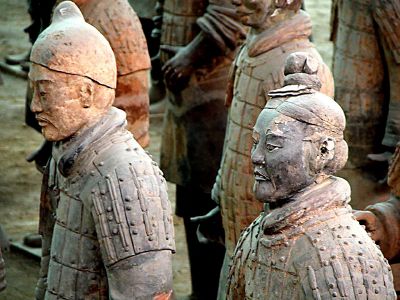
The first unified Chinese state was established by the Qin Dynasty in 221 B.C.E., when the office of the Emperor was set up and the Chinese language and measures were forcibly standardized. This state did not last long, as its legalist policies soon led to widespread rebellion. Unfortunately, in this short period the emperor ruthlessly ordered the burning of the Classics and the burying alive of several hundred Confucian scholars. These events caused enormous disturbances in the transmission of Chinese culture.
The subsequent Han Dynasty ruled China between 206 B.C.E. and 220 C.E., and created a lasting Han cultural identity among its populace that would endure to the present day. The Han Dynasty expanded China's territory considerably with military campaigns reaching Korea, Vietnam, Mongolia, and Central Asia, and also helped establish the Silk Road in Central Asia. The Han played an important role in restoring and protecting the Classics, engraving them even on stone or metal.
After Han's collapse, another period of disunion followed, including the highly chivalric period of the Three Kingdoms. Independent Chinese states of this period also opened diplomatic relations with Japan, introducing the Chinese writing system there. In 580 C.E., China was reunited under the Sui. However, the Sui Dynasty was short-lived after a loss in the Goguryeo-Sui Wars (598-614) weakened it.

Under the succeeding Tang and Song dynasties, Chinese technology and culture reached its zenith. The Song dynasty was the first government in world history to issue paper money and the first Chinese polity to establish a permanent standing navy. Between the tenth and eleventh centuries, the population of China doubled in size. This growth came about through expanded rice cultivation in central and southern China, along with the production of abundant food surpluses. Within its borders, the Northern Song Dynasty had a population of some 100 million people. The Song Dynasty was a culturally rich period in China for the arts, philosophy, and social life. Landscape art and portrait paintings were brought to new levels of maturity and complexity since the Tang Dynasty, and social elites gathered to view art, share their own, and make trades of precious artworks. Philosophers such as Cheng Yi and Chu Hsi, 1130-1200 reinvigorated Confucianism with new commentaries, infused Buddhist ideals, and emphasis on new organization of classic texts that brought about the core doctrine of Neo-Confucianism.
In 1271, Mongol leader Kublai Khan established the Yuan Dynasty, with the last remnant of the Song Dynasty falling to the Yuan in 1279. While Chu Hsi (Zhu Xi) was not so much recognized in his life time, the new Mongol leaders saw the potential of his thinking as a base for the nation. They were clever enough to develop good relations with great Confucian scholars and progressively the preparation of state examinations to become a civil servant required the study of the Classics with the commentary of Zhu Xi.
A peasant named Zhu Yuanzhang overthrew the Mongols in 1368 and founded the Ming Dynasty. Ming Dynasty thinkers such as Wang Yangming would further critique and expand Neo-Confucianism with ideas of individualism and innate morality that would have tremendous impact on later Japanese thought. Chosun Korea also became a nominal vassal state of Ming China and adopted much of its Neo-Confucian bureaucratic structure.
The site of the Forbidden City was part of the Imperial city during the Mongol Yuan Dynasty. Upon the establishment of the Ming Dynasty, the Hongwu Emperor Zhu Yuanzhang, who was the founding emperor of the Ming dynasty, moved the capital from Beijing in the north to Nanjing in the south, and ordered that the Mongol palaces be razed. When his son Zhu Di became the Yongle Emperor, he moved the capital back to Beijing, and in 1406 construction began on what would become the Forbidden City. The Ming fell to the Manchus in 1644, who then established the Qing Dynasty.
The Qing Dynasty, which lasted until 1912, was the last dynasty in China. In the nineteenth century the Qing Dynasty adopted a defensive posture towards European imperialism, even though it engaged in imperialistic expansion into Central Asia itself. At this time China awoke to the significance of the rest of the world, in particular the West. As China opened up to foreign trade and missionary activity, opium produced by British India was forced onto Qing China. Two Opium Wars with Britain weakened the Emperor's control.
One result was the Taiping Civil War which lasted from 1851 to 1862. It was led by Hong Xiuquan, who was partly influenced by a misinterpretation of Christianity. Hong believed himself to be the son of God and the younger brother of Jesus. Although the Qing forces were eventually victorious, the civil war was one of the bloodiest in human history, costing at least twenty million lives (more than the total number of fatalities in the First World War), with some estimates up to two-hundred million. In addition, more costly rebellions in terms of human lives and economics followed the Taiping Rebellion such as the Punti-Hakka Clan Wars (1855-1867), Nien Rebellion (1851-1868), Muslim Rebellion (1862-1877), Panthay Rebellion (1856-1873) and the Miao Rebellion (1854-1873).[10] [11] These rebellions resulted in an estimated loss of several million lives for each rebellion and in disastrous results for the economy and the countryside.[8][12] The flow of British opium led to more decline.
While China was torn by continuous war, Meiji Japan succeeded in rapidly modernizing its military with its sights on Korea and Manchuria. Maneuvered by Japan, Korea declared independence from Qing China's suzerainty in 1894, leading to the First Sino-Japanese War, which resulted in China's humiliating secession of both Korea and Taiwan to Japan. Following these series of defeats, a reform plan for Qing China to become a modern Meiji-style constitutional monarchy was drafted by the Emperor Guangxu in 1898, but was opposed and stopped by the Empress Dowager Cixi, who placed Emperor Guangxu under house arrest in a coup d'état. Further destruction followed the ill-fated 1900 Boxer Rebellion against westerners in Beijing. By the early twentieth century, mass civil disorder had begun, and calls for reform and revolution were heard across the country. The 38 year-old Emperor Guangxu died under house arrest on November 14, 1908, suspiciously just a day before Cixi. With the throne empty, he was succeeded by Cixi's handpicked heir, her two year old nephew Puyi, who became the Xuantong Emperor, the last Chinese emperor. Guangxu's consort, who became the Empress Dowager Longyu, signed the abdication decree as regent in 1912, ending two thousand years of imperial rule in China. She died, childless, in 1913.
Republic of China (1912-1949)
On January 1, 1912, the Republic of China (ROC) was established, heralding the end of the Qing Dynasty. Revolutionary leader Sun Yat-sen was proclaimed provisional president of the republic. However, Yuan Shikai, a former Qing general who had defected to the revolutionary cause, soon usurped the presidency by forcing Sun to step aside. Yuan then attempted to declare himself emperor of a new dynasty, but died of natural causes before securing power over all of the Chinese empire.
After Yuan Shikai's death, China was politically fragmented, with an internationally recognized, but virtually powerless, national government seated in Beijing. Warlords in various regions exercised actual control over their respective territories. In the late 1920s, the Kuomintang (KMT or Nationalist Party), under Chiang Kai-shek, was able to reunify the country under its own control, moving the nation's capital to Nanjing (Nanking) and implementing "political tutelage," an intermediate stage of political development outlined in Sun Yat-sen's program for transforming China into a modern, democratic state. Effectively, political tutelage meant one-party rule by the Kuomintang.
The Sino-Japanese War of 1937-1945 (part of World War II) forced an uneasy alliance between the Nationalists and the Communists as well as caused around ten million Chinese civilian deaths. With the surrender of Japan in 1945, China emerged victorious but financially drained. The continued distrust between the Nationalists and the Communists led to resumption of the Chinese Civil War. In 1947, constitutional rule was established, but because of the ongoing Civil War many provisions of the ROC constitution were never implemented on the mainland.
The PRC and ROC (1949-Present)
After its victory in the Chinese Civil War, the Communist Party of China (CCP), led by Mao Zedong, controlled most of Mainland China. On October 1, 1949, they established the People's Republic of China (PRC), laying claim as the successor state of the ROC. The central government of the ROC was forced to retreat to the island of Taiwan. On mainland China, the victorious Communists claimed they ruled the sole and only China (which they claimed included Taiwan) and that the Republic of China no longer existed.
Although the ROC government continued to claim to be the legitimate representative of China, since 1950 its effective jurisdiction has been limited to Taiwan and several small islands: Penghu, Kinmen, and Matsu. Beginning in the late 1970s, the Republic of China began the implementation of full, multi-party, representative democracy in the territories still under its control.
Following Mao's death in 1976, and the arrest of the Gang of Four blamed for the excesses of the Cultural Revolution, Deng Xiaoping quickly wrestled power from Mao's anointed successor, Hua Guofeng. Deng's influence led the country to economic reforms of significant magnitude, and some relaxation of control over certain areas of society. However, the Chinese government still maintained absolute control over politics, and it continually seeks to eradicate threats to the stability of the country. Examples include the fight against terrorism, jailing of political opponents and journalists, regulation of the press, regulation of religion, and suppression of independence/secessionist movements. In 1989, the student protests at Tiananmen Square were violently put to an end by the Chinese military after 15 days of martial law.
In 1997 Hong Kong was returned to the PRC by the United Kingdom and in 1999 Macau was returned by Portugal.
In 2012, Xi Jinping assumed the leadership of the PRC. Said to be one of the most powerful leaders in modern Chinese history, Xi's political thoughts have been written into the party and state constitutions, and under his leadership the latter was amended to abolish term limits for the presidency.
Society
Culture
China's traditional values were derived from various versions of Confucianism, the official philosophy throughout most of Imperial China's history. For centuries, economic and social advancement in China could be provided by high performance on the imperial examinations, which required applicants to write essays and demonstrate mastery of the Confucian classics. Those who passed the highest level of the exam became elite scholar-officials known as jinshi, a highly esteemed socio-economic position. This led to a meritocracy, although it was available only to males who could afford test preparation.
A number of more authoritarian strains of thought have also been influential, such as Legalism. There was often conflict between the philosophies, for example, the Song Dynasty Neo-Confucians believed that Legalism departed from the original spirit of Confucianism.
With the rise of Western economic and military power beginning in the mid-nineteenth century, non-Chinese systems of social and political organization gained adherents in China. Some of these would-be reformers totally rejected China's cultural legacy, while others sought to combine the strengths of Chinese and Western cultures. In essence, the history of twentieth century China is one of experimentation with new systems of social, political, and economic organization that would allow for the reintegration of the nation in the wake of dynastic collapse.
Arts, scholarship, and literature
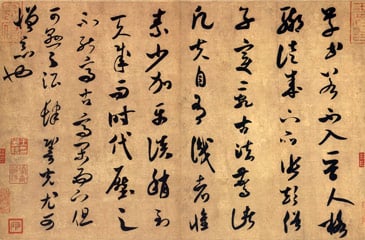
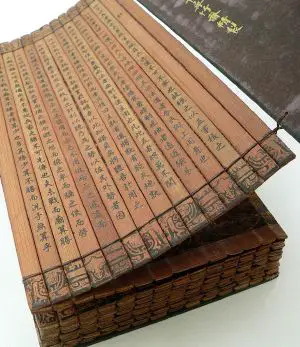
Chinese characters have had many variants and styles throughout Chinese history. Tens of thousands of ancient written documents are still extant, from Oracle bones to Qing edicts. This literary emphasis affected the general perception of cultural refinement in China, such as the view that calligraphy was a higher art form than painting or drama. Manuscripts of the classics and religious texts (mainly Confucian, Taoist, and Buddhist) were handwritten by ink brush. Calligraphy later became commercialized, and works by famous artists became prized possessions.
Chinese literature has a long history; the earliest classic work in Chinese, the I Ching or "Book of Changes" dates to around 1000 B.C.E. A flourishing of philosophy during the Warring States Period produced such noteworthy works as Confucius's Analects and Laozi's Tao Te Ching. Dynastic histories were often written, beginning with Sima Qian's seminal Records of the Historian. The Tang Dynasty witnessed a poetic flowering, while the Four Great Classical Novels of Chinese literature were written during the Ming and Qing Dynasties.
Printmaking in the form of movable type was developed during the Song Dynasty. Academies of scholars sponsored by the empire were formed to comment on the classics in both printed and handwritten form. Royalty frequently participated in these discussions as well. The Song Dynasty was also a period of great scientific literature, such as Su Song's Xin Yixiang Fayao and Shen Kuo's Dream Pool Essays.
Chinese philosophers, writers, and poets were highly respected, and played key roles in preserving and promoting the culture of the empire. Some classical scholars, however, were noted for their daring depictions of the lives of the common people, often to the displeasure of authorities.
The Chinese invented numerous musical instruments, such as the zheng (zither with movable bridges), qin (bridgeless zither), and xiao (vertical flute) and adopted and developed others such the erhu (alto fiddle or bowed lute) and pipa (pear-shaped plucked lute), many of which have later spread throughout East Asia and Southeast Asia, particularly to Japan, Korea, and Vietnam.
Demography
Hundreds of ethnic groups have existed in China throughout its history. The largest ethnic group in China by far is the Han. This group is diverse in itself and can be divided into smaller ethnic groups that share some traits. China is 91% Han, but is home to 55 other ethnic groups with distinct languages and cultures.
Over the last three millennia, many previously distinct ethnic groups in China have been Sinicized into a Han identity, which over time dramatically expanded the size of the Han population. However, these assimilations were usually incomplete and vestiges of indigenous language and culture often are still retained in different regions of China. Because of this, many within the Han identity have maintained distinct linguistic and cultural traditions, though still identifying as Han. Several ethnicities have also dramatically shaped Han culture, for example, the Manchurian clothing called the qipao became the new "Chinese" fashion after the seventeenth century, replacing earlier Han styles of clothing such as the Hanfu. The term Chinese nation (Zhonghua Minzu) is usually used to describe a notion of a Chinese nationality that transcends ethnic divisions.
Languages
Most languages in China belong to the Sino-Tibetan language family, spoken by 29 ethnicities. There are also several major dialects within the Chinese language itself. The most spoken dialects are Mandarin (spoken by over 70 percent of the population), Wu (Shanghainese), Yue (Cantonese), Min, Xiang, Gan, and Hakka.
Classical Chinese was the written standard for thousands of years in China and allowed for written communication between speakers of various unintelligible languages and dialects in China. Modern Chinese is the written standard based on the Mandarin dialect first popularized in Ming dynasty novels and was adopted (with significant modifications) during the early twentieth century as the national vernacular. Classical Chinese is still intelligible to some degree by many Chinese.
Religion
The faith held by most Chinese until the overthrow of the last dynasty is a pantheistic system, centering on the worship of "Heaven" as an omnipotent force. This faith system pre-dated the development of Confucianism and Taoism or the introduction of Buddhism and Christianity. It has features of monotheism in that Heaven is seen as an omnipotent entity, endowed with personality but no corporeal form.
It must be noted that there was an important religious shift in Chinese antiquity from the Shang or Yin dynasty (1765-1122 B.C.E.) to the Zhou dynasty (Western Zhou 1121-771 and Eastern Zhou 770-256 B.C.E.). Under the Shang, the Chinese, particularly the king and higher people made offerings to Shangdi 上帝, literally Sovereign above, whom they considered as a supreme being taking care of people. This supreme deity controlled the forces of nature and human destiny. The Shang rulers offered sacrifices to higher spirits and to the spirits of their ancestors as a source of legitimacy. Furthermore the rulers and nobles practiced human sacrifice, ordering people to be buried alive with them at their death with the belief they would travel together to the next world. Sites have been discovered providing evidence of such practices. The French historian Henri Maspero mentioned in his China in Antiquity that in 678 B.C.E. 66 people were buried alive with a prince, at a time proximate to Confucius (551-479 B.C.E.).[13] Ordinary people who did not have access to higher religion and offering rituals often believed in ghosts, spirits, and mythical monsters.
Under the Zhou, another religious concept became predominant, the concept of Tian 天, Heaven. However, although Tian became predominant it kept a certain relation with Shangdi. The Shang Dynasty may have been very religious but it was plagued by certain aspects of barbarism including human sacrifice and cruel tortures. During the Zhou an evolution took place according to which there were less and less human sacrifices, and human responsibility was put forward. This led to the emergence of philosophy and a suspicion of strange religious practices. Confucius used the concept of Heaven with a close personal relationship, initiating the possibility of each person developing virtue, not only the ruler. Therefore more proper rites and rituals were elaborated and a Chinese humanism emerged that was to become the backbone of Chinese civilization and culture.
In popular belief, the Worship of Heaven includes the erection of shrines, the last and greatest being the Altar of Heaven in Beijing, and the offering of prayers. Manifestation of the powers of Heaven include weather and natural disasters. Although it gradually diminished in popular belief after the advent of Taoism and Buddhism, among others, some of its concepts remained in use throughout the pre-modern period and have been incorporated in later religions of China.
Taoism is an indigenous religion of China and is traditionally traced to the composition of Lao Zi's Tao Te Ching (The Book of Tao and Its Virtues) or to seminal works by Zhang Daoling. The philosophy of Taoism is centered on "the way"; an understanding of which can be likened to recognizing the true nature of the universe. Taoism in its unorganized form is also considered a folk religion of China.
Buddhism was introduced from South and Central Asia during the Han dynasty and became very popular among Chinese of all walks of life, embraced particularly by commoners, and sponsored by emperors in certain dynasties. The progress of Buddhism in China can be seen in two trends: First, a trend related to the textual schools from the fourth century to the eighth century with famous schools such as the Consciousness Only school, T’ien T’ai school, and the Hua Yen (Hwaom) school. The second trend saw the rejection of texts and the emphasis on spiritual experience from the seventh century, that initiated a revolution in Chinese Buddhism as a reaction against the complexity of study of the sutras and putting emphasis on meditation. This trend called chan in Chinese is known as zen in Japanese.
During the period of disunity that lasted until the Sui Dynasty in 580 C.E., Buddhism penetrated deeply into the different states. It was very active in Northern Wei that is remembered for its art, such as the great sculptures found at Longmen near Luoyang. The Wei artists were able to give a personal expression to this art which later influenced Korean and Japanese artists. Buddhism seems to have touched ordinary people who were looking for salvation and did not pay much attention to culture, but educated Confucianists opposed its development. Unfortunately persecution arose early against Buddhism and became severe from 446 to 452 and again in 845 C.E. In Southern Wei, Buddhism spread among the aristocracy. The elite was attracted to engage in metaphysical subjects. The emperor Wu of Liang (502-549) supported Buddhism and practiced it himself.
Despite opposition, Buddhism played a role in the reunification of China and flourished under the Tang. Early Tang emperors used Buddhism but also Confucianism and Taoism to consolidate their power. It is difficult not to mention Xuanzang (602-664), the famous Buddhist monk who traveled during the Tang to India from 627 to 643 to bring back important texts. He met many important Indian spiritual leaders and wrote records of Western regions. On his return he was welcomed by the emperor and contributed with other scholars to the translation of Buddhist texts into Chinese.
Mahayana (大乘, Dacheng) is the predominant form of Buddhism practiced in China, where it was largely Sinicized and later exported to Korea, Japan and Vietnam. Some subsets of Mahayana popular in China include Pure Land (Amidism) and Zen.
Ancestor worship was a major religious practice shared among all Chinese religions, and is still practiced in Taiwan and Hong Kong. Traditional Chinese culture, Taoism, Confucianism, and Chinese Buddhism all value filial piety as a chief virtue, and the act is a continued display of piety and respect towards departed ancestors. The Chinese generally offer prayers and food for the ancestors, incense and candles, and burn offerings of Joss paper. These activities are typically conducted at the site of ancestral graves or tombs, at an ancestral temple, or at a household shrine.
Judaism, Islam, and Christianity first arrived in China after the seventh century C.E. during the Tang Dynasty. Islam was later spread by merchants and craftsmen as trade routes improved along the Silk Road, while Christianity began to make significant inroads in China after the sixteenth century through Jesuit and later Protestant missionaries. In the first half of the twentieth century, many Jews arrived in Shanghai and Hong Kong during those cities' periods of economic expansion and also sought refuge from the Holocaust in Europe. Shanghai was particularly notable for its volume of Jewish refugees, as it was the only port in the world then to accept them without an entry visa.
In today's China, governed by the officially atheistic Chinese Communist Party, all religions are prohibited except those sanctioned by the State Bureau of Religion, such as the Three-Self Patriotic Church for Protestants, the Chinese Catholic Patriotic Association, and comparable organizations for other religions. Organizations with links to foreign bodies are banned. Thus, for example, the Vatican is prohibited from any role in overseeing Catholicism in China.
Sports and recreation
Physical fitness is highly regarded. It is common for the elderly to practice Tai Chi Chuan and qigong in parks.
China has many traditional sports. Chinese dragon boat racing occurs during the Duan Wu festival. Board games such as International Chess, Go (Weiqi), and Xiangqi (Chinese chess) are also common and have organized formal competitions. A form of soccer may have appeared in China around 1000 C.E.[14]
Popular sports include martial arts, table tennis, badminton, and more recently, golf. Basketball is popular among young people in crowded urban centers. In Taiwan, baseball is more popular due to American and Japanese influences.
Science and technology
Among the scientific accomplishments of ancient China were paper (not papyrus), printing, the early loadstone and magnetic compass, gunpowder, early seismological detectors, matches, dry docks, sliding calipers, the double-action piston pump, cast iron, the iron plow, the multi-tube seed drill, the wheelbarrow, the suspension bridge, the parachute, natural gas as fuel, the escapement mechanism for clocks, the water-powered armillary sphere, the chain drive, the raised-relief map, the propeller, the crossbow, and the cannon. Chinese astronomers were among the first to record observations of a supernova. Chinese mathematics evolved independently of Greek mathematics and is therefore of great interest in the history of mathematics.
China's science and technology fell behind that of Europe by the seventeenth century. Political, social, and cultural reasons have been given for this, although recent historians focus more on economic causes, such as the high level equilibrium trap. By the twenty-first century, however, China became better connected to the global economy and again placed greater emphasis on science and technology.
Notes
- ↑ Oxford English Dictionary (Oxford University Press, 2009, ISBN 0199573158).
- ↑ The American Heritage Dictionary of the English Language (Houghton-Mifflin, 2018, ISBN 1328841693).
- ↑ Beijing hit by eighth sandstorm BBC News (April 17, 2006). Retrieved December 15, 2024.
- ↑ 4.0 4.1 Rough Guides, China, (Rough Guides, 2017, ISBN 0241274001).
- ↑ Navjot S. Sodhi, Luke Gibson, and Peter H. Raven (eds.), Conservation Biology: Voices from the Tropics (Wiley-Blackwell, 2013, ISBN 0470658630).
- ↑ Russell Ciochon and Roy Larick, Early Homo erectus Tools in China Archaeology 53(1) (January/February 2000). Retrieved December 15, 2024.
- ↑ Liujiang Smithsonian. Retrieved December 15, 2024.
- ↑ 8.0 8.1 Jacques Gernet, A History of Chinese Civilization (Cambridge University Press, 1996, ISBN 0521497817).
- ↑ Stunning capital of Xia Dynasty unearthed China Daily (November 11, 2003). Retrieved December 15, 2024.
- ↑ Robert Darrah Jenks, Insurgency and Social Disorder in Guizhou: The "Miao" Rebellion, 1854-1873 (University of Hawaii Press, 1994, ISBN 0824815890).
- ↑ Willard J. Peterson (ed.), The Cambridge History of China, Vol. 9: The Ch'ing Dynasty, Part 1: To 1800 (Cambridge University Press, 2002, ISBN 0521243343).
- ↑ Elizabeth J. Perry, Rebels and Revolutionaries in North China, 1845-1945 (Stanford University Press, 1983, ISBN 0804711755).
- ↑ Henri Maspero, China in Antiquity (University of Massachusetts Press, 1979, ISBN 0870232967).
- ↑ The History Of Soccer. Retrieved December 15, 2024.
ReferencesISBN links support NWE through referral fees
- The American Heritage Dictionary of the English Language. Houghton-Mifflin, 2018. ISBN 1328841693
- Gernet, Jacques. A History of Chinese Civilization. Cambridge University Press, 1996. ISBN 0521497817
- Jenks, Robert Darrah. Insurgency and Social Disorder in Guizhou: The "Miao" Rebellion, 1854-1873. University of Hawaii Press, 1994. ISBN 0824815890
- Maspero, Henri . China in Antiquity. University of Massachusetts Press, 1979. ISBN 0870232967
- Oxford English Dictionary. Oxford University Press, 2009. ISBN 0199573158
- Perry, Elizabeth J. Rebels and Revolutionaries in North China, 1845-1945. Stanford University Press, 1983. ISBN 0804711755
- Peterson, Willard J. (ed.). The Cambridge History of China, Vol. 9: The Ch'ing Dynasty, Part 1: To 1800. Cambridge University Press, 2002. ISBN 0521243343
- Rough Guides China. Rough Guides, 2017. ISBN 0241274001
- Sodhi, Navjot S., Luke Gibson, and Peter H. Raven (eds.). Conservation Biology: Voices from the Tropics. Wiley-Blackwell, 2013. ISBN 0470658630
- Yu, Zhuoyun. Palaces of the Forbidden City. New York: Viking, 1984. ISBN 0670537217
Credits
New World Encyclopedia writers and editors rewrote and completed the Wikipedia article in accordance with New World Encyclopedia standards. This article abides by terms of the Creative Commons CC-by-sa 3.0 License (CC-by-sa), which may be used and disseminated with proper attribution. Credit is due under the terms of this license that can reference both the New World Encyclopedia contributors and the selfless volunteer contributors of the Wikimedia Foundation. To cite this article click here for a list of acceptable citing formats.The history of earlier contributions by wikipedians is accessible to researchers here:
The history of this article since it was imported to New World Encyclopedia:
Note: Some restrictions may apply to use of individual images which are separately licensed.
